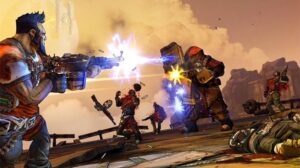Modo 901 is planned for the end of May 2015. In the meantime, the Foundry’s Brad Peebler and Shane Griffith offered a sneak peak of the new features.
The Foundry’s Modo group got out ahead of the NAB crowd to announce a major upgrade: Modo 901. Modo wants to live in many worlds including game development, design, and media creation and in this release, the company is working its way into those markets with a little something for everyone.

The Foundry’s head of US operations Brad Peebler and Shane Griffith, Modo product marketing manager talked about the upcoming product and highlighted the ways in which they have improved the integration of the Modo components within the product. They also talked quite a bit about the impact the user base has had on their development priorities. The Modo team has tried to stay close to their user base to understand their priorities and Pebber has said, a little ruefully, that the community has let them know when the development team got it wrong.
As part of the improved integration, MeshFusion is now an included part of the product. Introduced last year as an add-on, MeshFusion was developed by the talented GraBoto team as a tool for Sub-D modelers and enables Boolean operations so that objects can be combined and subtracted, resulting in a waterproof mesh. The Foundry has licensed the MeshFusion technology and two-developer team of Darrel Anderson and Boris Tsikanovsky has joined the Modo. As a result the MeshFusion engine has been improved and is well integrated in the Modo modeler.
The Modo team has worked on tools that make 3D printing more practical. Models can be sliced and the sides capped for a watertight model. This means that models that might be too big for the bed of a 3D printer can be split into parts, printed, and successfully glued together.
With new features that bring more solid modeling capabilities into the fluid design capabilities of the Modo modeler and The Foundry is improving the capabilities of Modo for industrial design.
The team has done quite a bit of work on UDIM and multi-tiled UVs to include improved packing, transfers, straightening, and alignment. It’s now possible to see the texture being baked on to the model, which means that modelers can go in and tweak the model to ease problem areas.
Peebler said he is particularly happy about the improvements made to the sculpting tools. Layer sculpting is possible at each mesh level. And it’s now possible to transfer multi-resolution displacement vectors between meshes.
The people at FX Guide have had an advance version of Modo 901 and what they have found to be particularly great is the implementation of MIS (multiple importance sampling) to improve rendering performance and quality. MIS was developed in 1997 by Eric Veach. Basically it uses multiple sampling approaches and combines them for the best effect. Check out the article at FX Guide for a much more detailed explanation of the technology that’s showing up in this latest version of Modo.
The latest version of Modo will ship at the end of May and will be $1799 for new seats. This is a price increase of $300, but Modo 801 is still available for purchase at its original price, and it can be upgraded to 901. In the broadcast of the Modo sneak peak, Peebler expressed some impatience with the inevitable grousing that came with the announcement that MeshFusion, which had been priced at $395 as an add-on kit for Modo would not be included in the base product. Customers asked, can we get our money back? Peebler said, if you’ve had it, you’ve been using it, and you’ve made money with it, you got your money’s worth. He also suggested that those who haven’t bought MeshFusion yet, could by Modo 801 at the reduced price and then upgrade to 901 and they’ll get the whole shebang for a $300 discount. The grumbling has seemed to die down.
The company has promised more new features to come with the product’s release and that is expected at the end of May.
What do we think?
It’s interesting to see the ways in which the worlds of 3D modeling for computer aided design and for entertainment content creation are coming together. On the CAD side there is implementation of Sub-D modeling tools because they are very easy to use compared to NURBS-based solid modeling. On the content creation side, the ability to build real-world models from digital models has a strong allure and Sub-D modelers make sense if they can be made to product air-tight meshes.
Where does that get us? It’s still the way of the world that industrial designers, and most people creating ads and visualizations, are more likely to use tools from the media creation world rather than CAD tools, and even repurposing CAD models for 3D printing, visualization, rendering, etc. might not make sense for some jobs. Modo and its competitors Rhino and SolidThinking Evolve are all poking at the boundaries of these markets.





